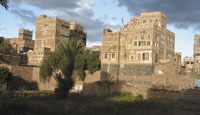
The Old City of Sana’a: Matchless beauty [Archives:2007/1115/Last Page]
December 27 2007
 |
History and literature books always mention the Old City of Sana'a, which is the central attraction for both foreigners and locals. I still remember when I met a foreigner on the roof of one of the area's homes. In discussing its history, a question occurred to me. “Why do you like this particular area, although you come from a huge and very modern city?” I asked him.
The visitor's answer contained a splendid description. He said, “The Old City of Sana'a reminds me of the fictional tales. Its houses, walls and decorations appear as if they were made of chocolate bars and cream.” The foreigner – whose name I can't remember – dwelt on the description of the area, which he truly loved.
I felt proud of the city, whose beauty is represented in its architecture, buildings, walls and streets that embrace love and warmth for visitors. This beauty originally belongs to Sana'ani society, which possesses its own exclusive traditions and customs.
In ancient times, successive rulers governed the Old City area, all attempting to organize its social life by issuing various laws and regulations. For example, they issued laws regulating sales and trade within its markets and other laws regarding the area's cleanliness. Thanks to the forefathers who lived within the Old City and had a sense of beauty to decorate their homes inside and out, they set an example of a modern civil society by adhering to cleanliness and tidiness.
Cleanliness within the Old City area grew out of both Islamic teaching, as well as the social customs and behaviors of its local residents and has become a peculiarity among citizens living there. Sana'a Commercial Law I and II issued during the reign of Imam Al-Mansour and his son regulated buying and selling in the Old City, as well as cleanliness. Additionally, municipal workers were assigned to keep the area clean, particularly the markets and stores, and residents were asked to keep the areas around their homes clean and tidy.
This cleanliness took different forms. Remarkably, sanitation was present throughout the area as public bathrooms were established in several areas. Designated cleaners then would carry such bathroom waste to areas outside the Old City via carriages driven by donkeys.
Decoration
Decoration is one of the forms of beauty within the Old City of Sana'a and is found on nearly all of its buildings. Such decorations include lettering from ancient languages and other Islamic calligraphy, as well as verses from the Qur'an and sayings of the Prophet Mohammed (pbuh).
Green areas are widespread within the Old City area and many gardens can be seen throughout. Representing another form of the area's beauty, they are considered good places for local residents to spend their time.
Recent studies suggest that orchards and gardens cover more than a third of the Old City area. Previously, every mosque was connected to an orchard and most of the palaces owned by emirs and other leaders in ancient times had very beautiful gardens.
Additionally, the city of Sana'a itself was surrounded by agricultural lands famous for producing grapes, from which wine was made in pre-Islamic times.
——
[archive-e:1115-v:15-y:2007-d:2007-12-27-p:lastpage]


